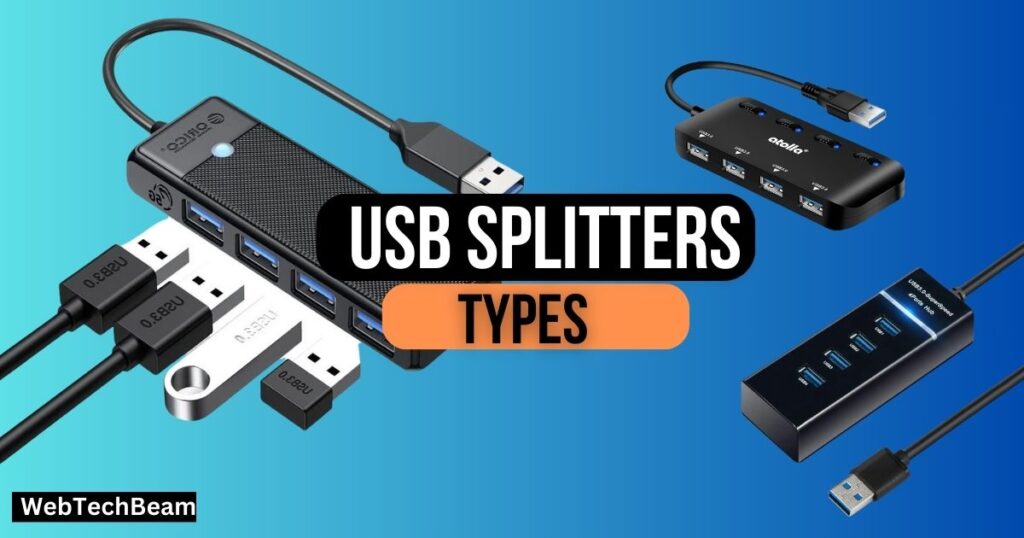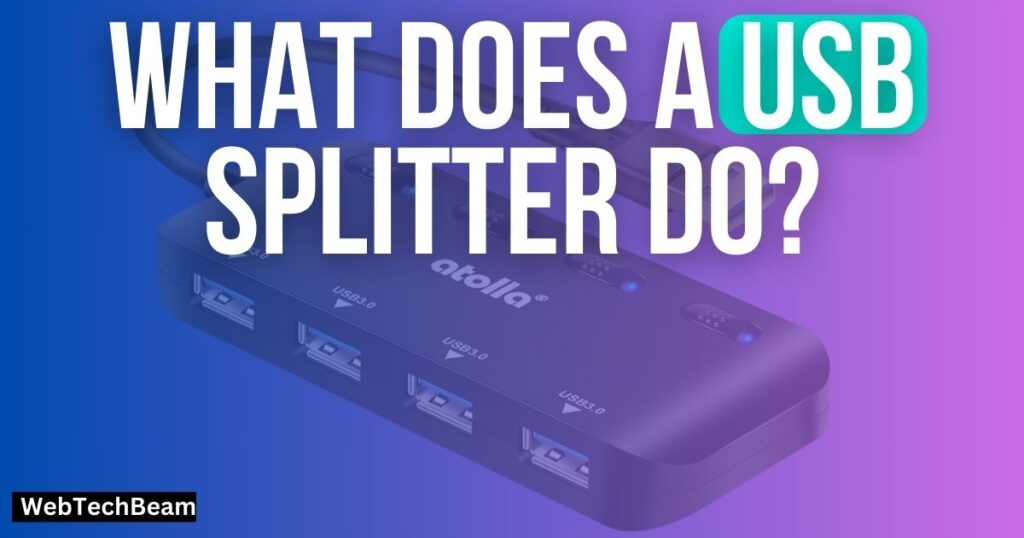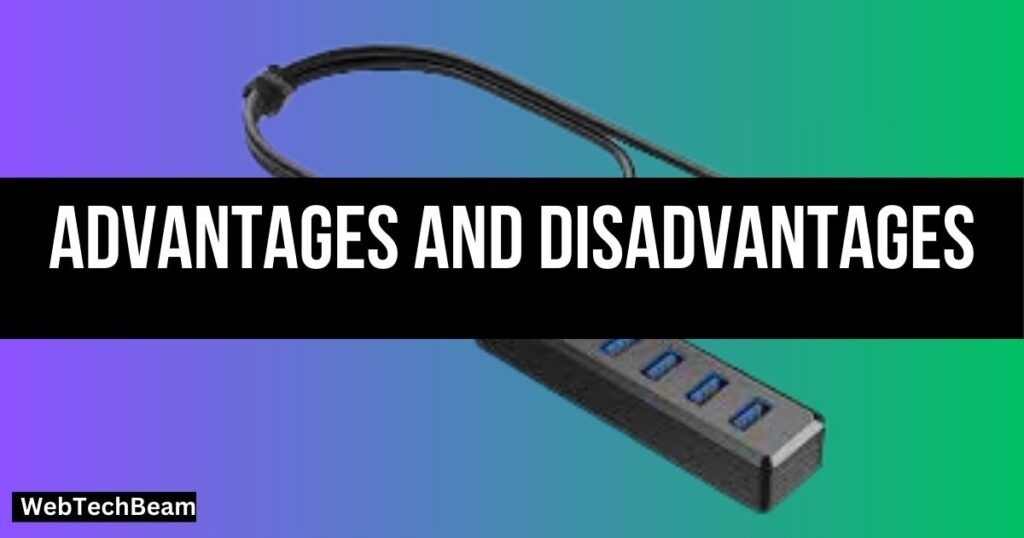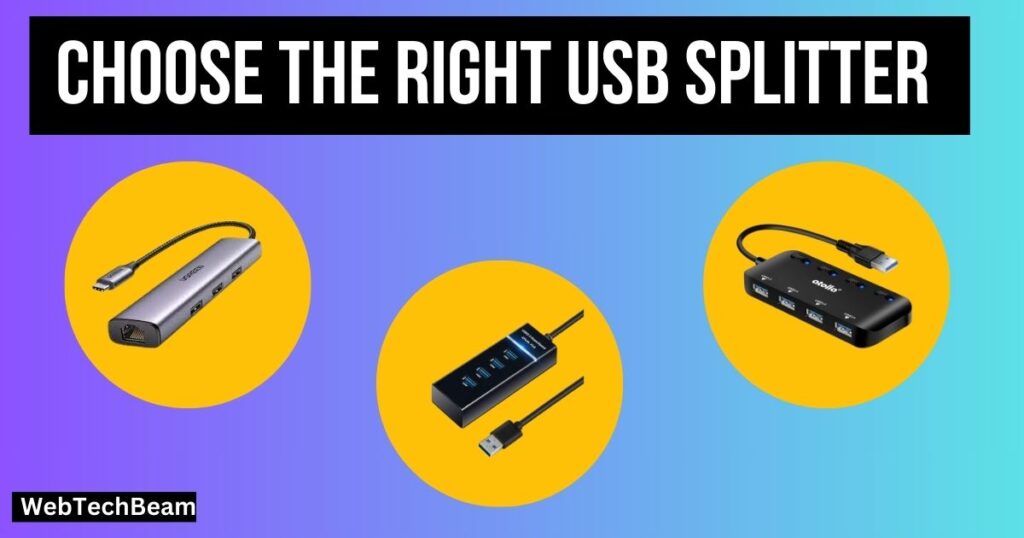A USB splitter is a handy device that enables you to connect multiple USB devices to just one USB port on your computer or other devices. It divides a single USB port into multiple ports, simplifying the process of using multiple devices simultaneously.
The USB splitter plays a vital role in expanding the available USB ports. With this device, you can connect multiple peripherals like a mouse, keyboard, flash drive, or external hard drive to a single USB port. It proves particularly beneficial for computers and laptops that have a limited number of USB ports.
USB splitters are regularly used in everyday situations to connect numerous peripherals to a computer. For example, if you have a laptop with only two USB ports but need to use a mouse, keyboard, and external storage device concurrently, a USB splitter would be accessible.
In skilled environments, these connectors prove to be valuable as they facilitate the connection of multiple USB devices to a single computer, thereby enhancing productivity.
Types of USB Splitters

Passive USB Splitters
Description and Examples
Passive USB splitters are basic gadgets designed to divide a single USB port into multiple ports, operating without the need for extra power sources. These splitters solely rely on the power supplied by the host USB port. A Y-cable serves as an example of a passive USB splitter, with one connector that connects to the computer and multiple USB ports at the other end.
Pros and Cons
- Pros:
- Affordable and easy to find.
- An external power source is unnecessary.
- Lightweight and portable.
- Cons:
- Insufficient power supply can restrict the operation of power-hungry devices.
- If there are too many devices connected at the same time, performance may vary.
Active USB Splitters
Description and Examples
USB splitters, alternatively referred to as drive USB hubs, boast an energetic feature of possessing their own power supply. These splitters are accompanied by a distinct power adapter, which efficiently supplies power to the devices they are connected to. For instance, there are drive USB hubs capable of powering multiple devices simultaneously, including printers, external hard drives, and various other peripherals.
Pros and Cons
- Pros:
- Ensures stable performance by providing ample power to all connected devices.
- Can support more power-demanding devices.
- Passive splitters typically have fewer ports when compared to active splitters.
- Cons:
- Passive USB splitters are less expensive than them.
- Portability may be limited as it necessitates access to an external power outlet.
Powered vs. Unpowered Splitters
Key Differences and Applications
- Powered Splitters:
- Require an external power source.
- This is perfect for powering devices that require a lot of energy.
- Ideal for setups requiring secure and dependable connectivity.
- Unpowered Splitters:
- An external power source is not required.
- Ideal for low-power devices and short-term installations.
- For travel or when you’re on-the-go, it offers greater portability and convenience.
The choice between powered and unpowered splitters will be influenced by your specific requirements, the devices you intend to use, and the environment in which you plan to utilize the splitter.
If you have numerous high-power USB devices in your home or office structures, an active (powered) splitter would be the ideal choice. However, for simpler uses that don’t require much power, a passive (unpowered) splitter is usually enough.
What Does a USB Splitter Do?

A USB splitter enables the connection of multiple USB devices to your computer through a single USB port. By dividing a single available USB port into multiple ports, it allows for simultaneous connectivity of multiple USB devices.
This way, you can use a mouse, keyboard, flash drive, and other devices simultaneously without consecutively running out of USB ports on your computer.
When you require additional USB networks, the solution is straightforward.
Technical Specifications of USB Splitters
USB Versions
Compatibility with USB 2.0, 3.0, and later versions
USB splitters are designed to be compatible with various USB versions, including USB 2.0, USB 3.0, USB 3.1, and USB 3.2. By supporting these versions, the splitter ensures optimal performance when connecting high-speed devices. USB 3.0 and newer versions provide faster data transfer speeds compared to USB 2.0, making them ideal for seamless connectivity.
Port Limitations and Bandwidth
Maximum number of devices supported
The capacity of a USB splitter to support devices can differ. Simple splitters typically offer 2-4 additional ports, whereas larger, powered hubs can provide 7 or more ports. Nevertheless, it is crucial to review the splitter’s specifications to determine its maximum capacity.
Impact on data transfer speeds
When connecting multiple devices to a single USB port via a splitter, the available bandwidth is shared among all linked devices. This means that the more devices you connect, the slower the data transfer speed for each device may become. USB 3.0 splitters classically handle higher bandwidth, which helps manage multiple devices more effectively.
Power Requirements
Power draw and distribution
Passive splitters, which distribute power from the computer’s USB port, may restrict the performance of numerous connected devices, especially those with high power requirements. On the contrary, active splitters have their own power source, ensuring that each connected device receives sufficient power to achieve optimal performance.
Use cases for powered splitters
If you need to connect power-hungry devices such as external hard drives, printers, or multiple peripherals simultaneously, powered splitters are the perfect solution. Whether it’s for a home or office setup, ensuring a stable and reliable connection is vital for productivity. These splitters supply additional power to prevent overloading the computer’s USB port, guaranteeing that all devices operate smoothly and correctly.
How Are USB Splitters Used in Everyday Life?
Home and Office Applications
The practice of utilizing USB splitters is widespread both at home and in professional settings. These handy devices enable the connection of multiple peripherals, such as a keyboard, mouse, printer, and external hard drive, to a solitary USB port on your computer. This setup not only helps maintain a tidy workspace but also enhances productivity by granting simultaneous access to all connected devices.
Gaming Setups
USB splitters are a game-changer for gamers as they offer enhanced connectivity options. With additional ports, gamers can easily connect gaming controllers, headsets, external hard drives, and various other peripherals. This eliminates the hassle of continuously swapping and tidying up devices, resulting in a much more seamless and enjoyable gaming experience.
Mobile Devices
A USB splitter offers great convenience when used with laptops and mobile devices. Given that these devices often have a restricted number of USB ports, a splitter provides additional connectivity alternatives.
This is especially convenient when you are on the go or using different locations for work or play. It enables you to easily connect devices such as a mouse, keyboard, and external storage.
Advantages and Disadvantages

Advantages
- Increased flexibility and convenience: USB splitters allow you to connect various peripherals to a single USB port, enhancing your aptitude for multitasking and making it cooler to use many devices without continually working and unplugging them.
- Cost-effective solution for multiple device connections: Investing in a USB splitter is usually more inexpensive than upgrading your existing hardware to accommodate more USB ports. This solution provides a sensible way to range the ability of your recent setup without an important financial expense.
Disadvantages
- Possible reduction in data transfer speed: When several devices are devoted to a single USB port via a splitter, the available bandwidth is shared between all connected devices. This circulation can lead to gentler data transferal speeds for each connected device, principally if you’re using a slothful splitter or connecting high-speed devices.
- Potential power limitations with unpowered splitters: Passive splitters draw power from the computer’s USB port, which might not be adequate for power-intensive devices. This restriction can result in reduced performance or complete functionality loss for certain peripherals. Powered splitters moderate this issue by if an external power spring, but they also come with more costs and need access to an electrical outlet.
Is It Safe to Use a USB Splitter?
Yes, it is safe to use a USB splitter, but there are a few things to keep in mind to ensure everything works properly. If you are using a slothful splitter (one that doesn’t have its own power source), make sure not to attach too many high-power devices, as this can spare your computer’s USB port and cause difficulties. For example, joining too many external hard drives or other power-hungry devices might not work well with a passive splitter.
In contrast, active splitters possess their own power supply, making them a more secure option for connecting multiple devices. They guarantee sufficient power distribution to each device, allowing for seamless utilization of numerous peripherals.
To make the best decision based on your requirements, it is crucial to evaluate the conditions and assess the splitter’s capabilities in terms of port count and power delivery.
Expanding your USB networks is generally considered safe and appropriate, provided that you adhere to the specified limits of the USB splitter and follow the guidelines set by the manufacturer.
How Do You Choose the Right USB Splitter?

Factors to Consider
Number of ports needed: Before ordering a USB splitter, consider how many devices you need to attach at the same time. If you just need to attach a few peripherals like a mouse and keyboard, a splitter with 2-4 ports might be enough. However, for wider setups, such as in an office environment, you might need a splitter with 7 or more ports.
Power requirements of connected devices: It’s important to know if your devices need extra power. If you are connecting devices that use a lot of authority, like external hard drives or copiers, an active (powered) splitter is essential. On the other hand, for low-power devices like a mouse or keyboard, an impassive (unpowered) splitter can work just fine.
Data transfer speed needs: Consider the speed at which you need to transfer data. USB 3.0 splitters provide closer data transfer speeds related to USB 2.0. If you’re using high-speed devices, select a splitter that supports USB 3.0 or later to confirm effectual performance.
Top Brands and Models
Overview of reputable brands and popular models: Some well-known brands offer reliable USB splitters. Look for models from brands like Anker, Belkin, and Sabrent.
These companies are renowned for manufacturing USB splitters that are robust and deliver exceptional performance. It is advisable to refer to reviews and user ratings to select the most suitable model based on your requirements.
Conclusion
To put it briefly, a USB splitter is an invaluable tool enabling the connection of multiple peripherals to just one USB port on a computer. This device offers enhanced connectivity options, particularly beneficial for gamers, laptop users, and individuals requiring simultaneous connections to multiple devices.
It is crucial to choose the correct USB splitter that caters to your requirements. Take into account the number of ports, power deliveries of your devices, and data transfer speeds. By investing in the suitable splitter, you can enhance your experience with a more streamlined and effective setup.
Enhance Your Connectivity: The Ultimate Guide to USB Splitters – Web Tech Beam Best info 2024

